“The doctrine of Manifest Destiny, which in the 1840s had seemed Heaven-sent, proved to have been a bomb wrapped up in idealism.”
So wrote the historian Frederick Merk in 1963.
In ‘Entity’ (S4, Ep20), SG-1 discovers—perhaps for the first time but certainly not the last—the perils of taking foreign policy to the cosmos. Undergirding the long-form mythology of Stargate SG-1 is the clash of empires. Aspiring American, Russian, and Chinese ones … yes, certainly, but also the preexisting Goa’uld and Ori empires. The latter two, in fact, could be channeling their own versions of Pope Alexander VI (1431-1503).
Alexander VI is credited with the Doctrine of Christian Discovery, published on May 4, 1493. It decreed, among many other things, that lands not inhabited by Christians could be seized and exploited, and “the Catholic faith and the Christian religion [shall] be exalted and be everywhere increased and spread, that the health of souls be cared for and that barbarous nations be overthrown and brought to the faith itself.”
Looking for excuses to push Native Americans off their lands, the U.S. government would reach back to Alexander XVI’s papal bull, with Chief Justice John Marshall citing it in an 1823 ruling, writing for the Supreme Court majority, “indigenous peoples possess ‘occupancy’ rights, meaning their lands could be taken by the powers of ‘discovery.’” (This might be the most infamous Supreme Court clapback until Justice Samuel Alito invoked Salem Witch Trials judge Sir Matthew Hale in order to find a precedent to outlaw abortion.)
In formulating the 1814 treaty which ended the War of 1812, the American contingent, led by John Quincy Adams, got in touch with their inner System Lords and wrote that their goal was to “reclaim from the state of nature, and to bring into cultivation every portion of the territory contained within their acknowledged boundaries.” British diplomat Henry Goulburn was aghast, penning, “Till I came here [Ghent], I had no idea of the fixed determination which there is in the heart of every American to extirpate the Indians and appropriate their territory.”
Indigenous peoples in the Americas being felled by literally foreign diseases as early as Christopher Columbus’ arrival in the New World in 1492 and such illnesses were rampant by the 1550s. As ‘civilization’ spread westward, some malign opportunists decimated Native Americans with alcohol and smallpox-infected blankets, a subtle form of genocide. Nor is this an antique phenomenon. “During the late 1950s and 1960s, a group of Yanomami living near the Venezuelan border was nearly wiped out by measles and another contagious disease after they contacted the outside world,” grimly reports Science.
Jack O’Neill would not be amused
The term “Manifest Destiny” would not be coined until 1845, either by journalist John O’Sullivan or polemicist Jane Cazneau. In its formulation by Sullivan, “to establish on earth the moral dignity and salvation of man,” it sounds like a sentiment that would be right at home on the lips of Teal’c (Christopher Judge). O’Sullivan’s ideal subsequently morphed into “our manifest destiny [is] to overspread the continent allotted by Providence for the free development of our yearly multiplying millions,” more in line with the agenda put forward by Stargate’s Pentagon, with whom Col. Jack O’Neill (Richard Dean Anderson) is frequently at odds.
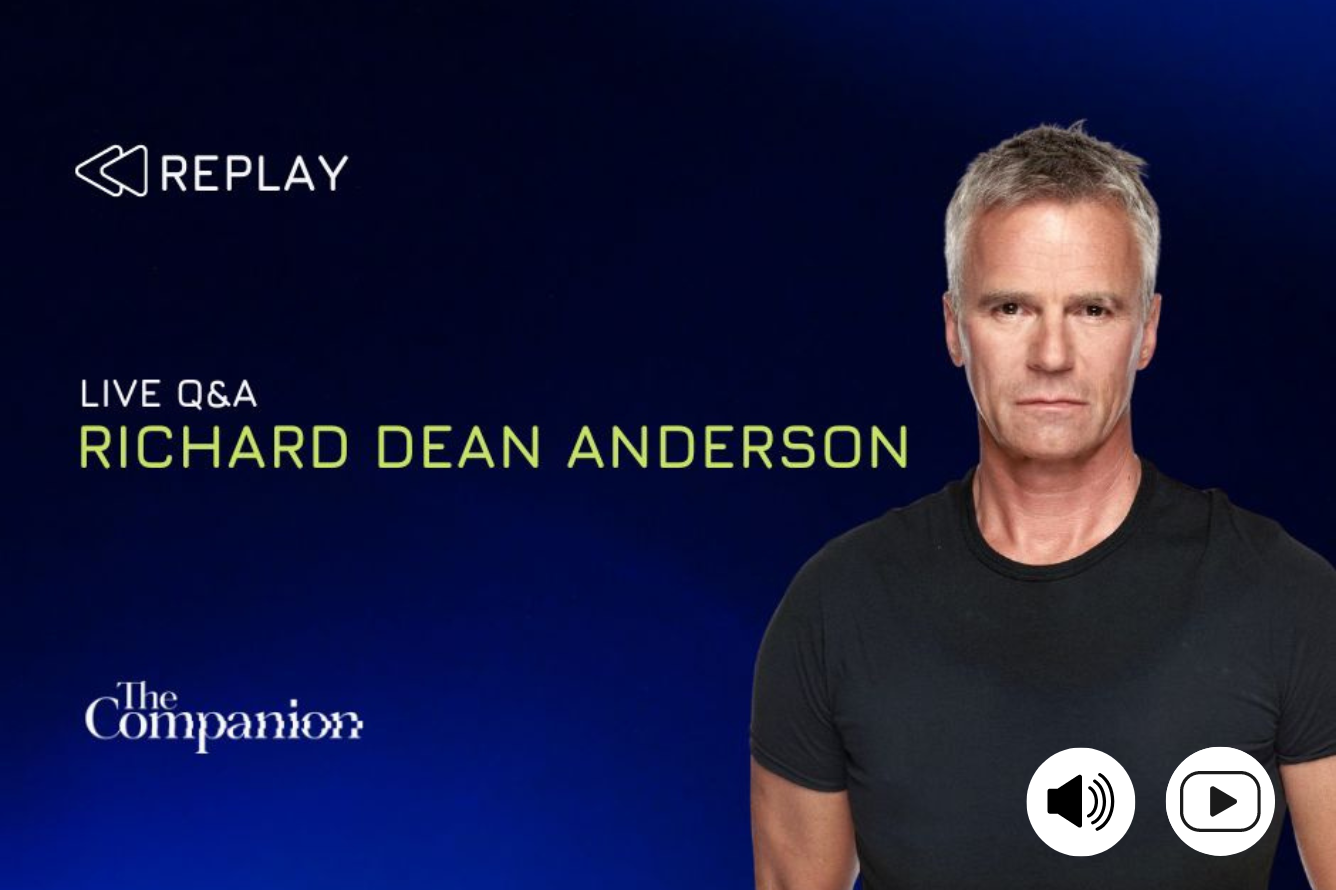
Indeed, Jack himself could have uttered “I suppose the right of a manifest destiny to spread will not be admitted to exist in any nation except the universal Yankee nation.” However, that dissent was actually voiced on January 3, 1846, by Rep. Robert Winthrop.
Manifest Destiny was described as “the mission of this country to spread civil and religious liberty over all the world” by John C. Calhoun (January 4, 1848), which is also the unspoken mission statement of SG-1, overarching its stated goal of acquiring new technology. SG-1 is engaged in “extending the area of freedom,” as President Andrew Jackson would put it. Calhoun was not a fan of the Manifest Destiny concept. Historian Daniel Walker Howe, writing in 2007, recalled, “American imperialism did not represent an American consensus; it provoked bitter dissent within the national polity while the Whigs saw America’s moral mission as one of democratic example rather than conquest.”
And that last phrase, “democratic example rather than conquest,” describes exactly how SG-1 operates. (Which makes them latter-day Whigs, one supposes.) Star Trek’s Prime Directive is spurned in favor of a decidedly interventionist polity, one of bearing liberation from slavery and freedom to worship (or not) among the planets.
Enlightened Explorers Enter the Picture
SG-1 co-creator Brad Wright was never a proponent of Manifest Destiny. Indeed, Stargate Atlantis would depict a multilateral, multilingual foothold in the Pegasus Galaxy (albeit with no participation from Russia or China), where the establishment of a fragile colony awakens the more-imperialistic natures of the Genii and the Wraith.
However, with Stargate Universe, Wright and showrunner Robert C. Cooper backslid somewhat. In 1996, one year before Stargate SG-1 debuted, historian William E. Weeks boiled down Manifest Destiny to three components: virtue (which Stargate Command possesses in abundance), mission, and destiny. A mission aboard the spaceship Destiny rather speaks for itself, especially when it is one in search of divine, cosmic intelligence. Since Destiny’s five-year saga was aborted three years early by the System Lords of Syfy, we’ll never know if such Air Force presumption was to be rewarded.
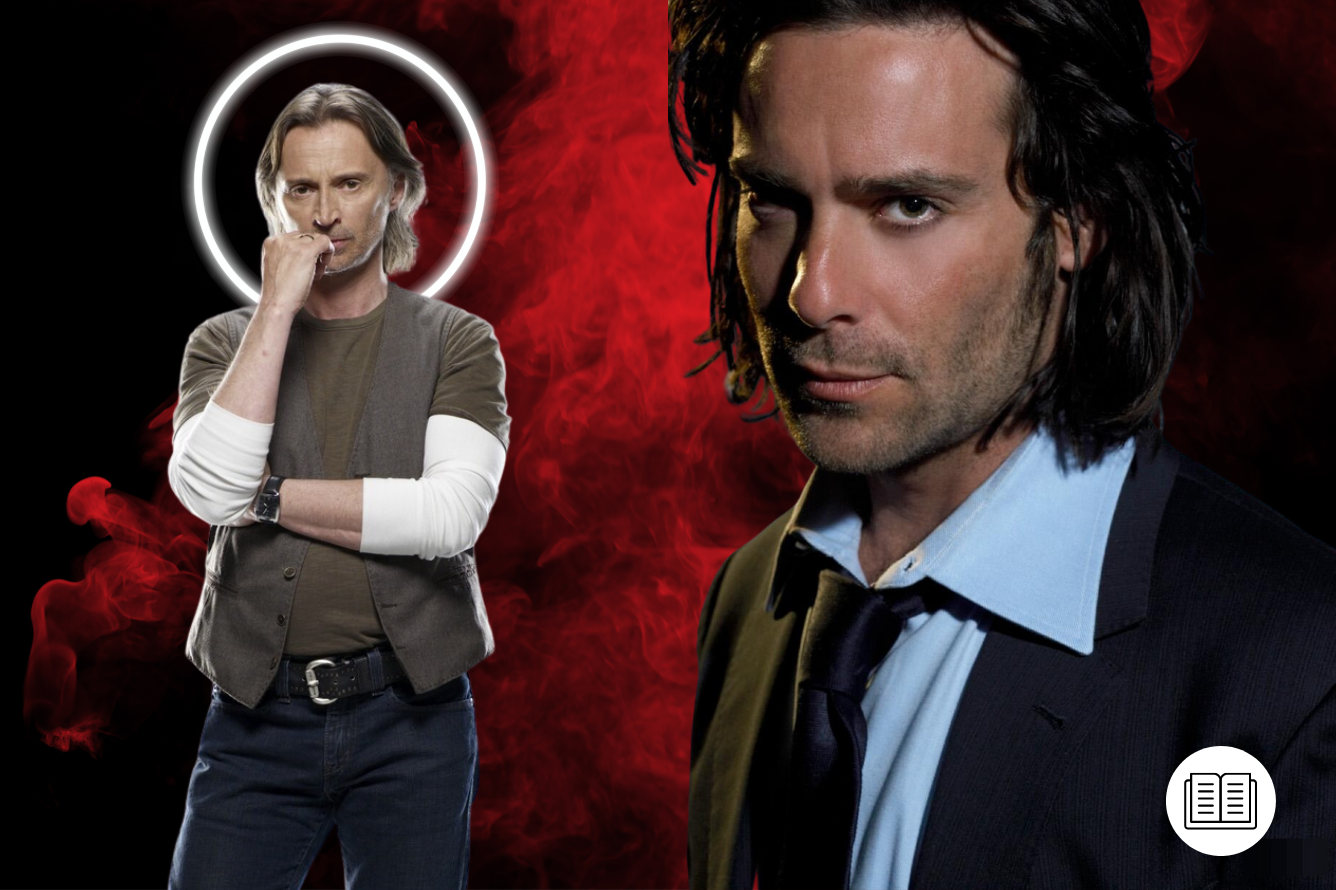
This brings us to ‘Entity’, the ‘smallpox blanket’ episode of Stargate SG-1, even more so than the comparatively comedic ‘One False Step’ (S2, Ep19), another favorite installment. ‘Entity’ is the most rigorous of SG-1’s bottle episodes and one of the finest, right up there with ‘Message in a Bottle’ (S2, Ep7) and ‘A Matter of Time’ (S2, Ep16) – Season 2 was pretty good, wasn’t it?. It also is noteworthy for being the first Stargate episode shot on high-definition video and the only one directed by SG-1 editor Allan Lee.
In his DVD commentary, Lee hints at reasons for his lack of a return invite, namely under preparation and a final product that displeased Wright. And while Lee found Amanda Tapping, Teryl Rothery, and Don S. Davis wonderfully easy to direct, Michael Shanks and Christopher Judge were quite another matter.
Primary credit for the success of ‘Entity’ goes to the scripting of Peter DeLuise, who may not have been pondering Manifest Destiny but clearly gave serious thought to the concept of blowback from being “peaceful explorers” willy-nilly penetrating the galaxy. He’s also a proponent of strong female characters, whether as writer here, director (‘Beneath the Surface’ – S4, Ep10), or both in one (‘Death Knell’ – S7, Ep16), which will work to the benefit of ‘Entity’.
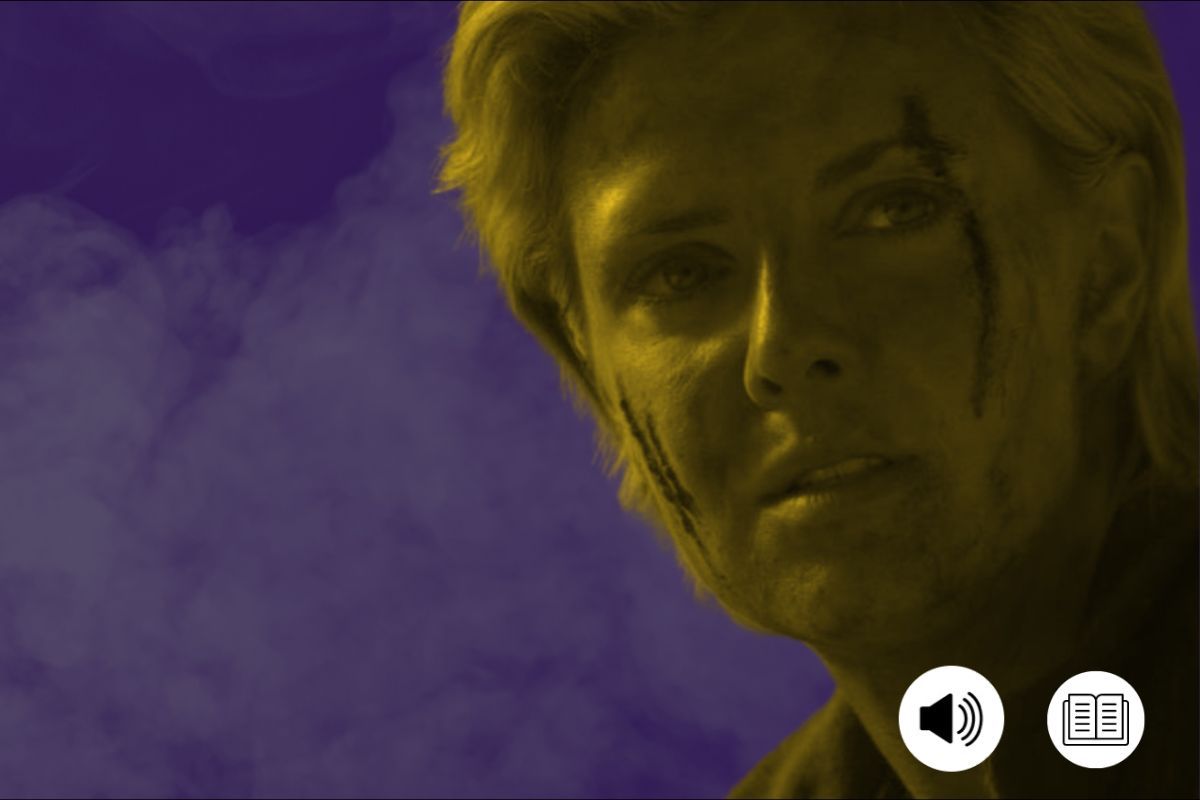
Ghost in the Machine, Literally
The cold open finds SG-1 assembling in the Gate Room to witness a seemingly routine MALP transmission from an as-yet-unexplored world. O’Neill’s belated arrival provokes some gentle sarcasm from Gen. Hammond (Don S. Davis), followed by this bit of levity …
Jack O’Neill (to Teal’c): You look tense.
Daniel Jackson: I would say anxious.
Teal’c: I am neither tense nor anxious. Perhaps concerned.
Daniel Jackson: Why?
Teal’c: The address of this planet was procured from the repository of the Ancients.
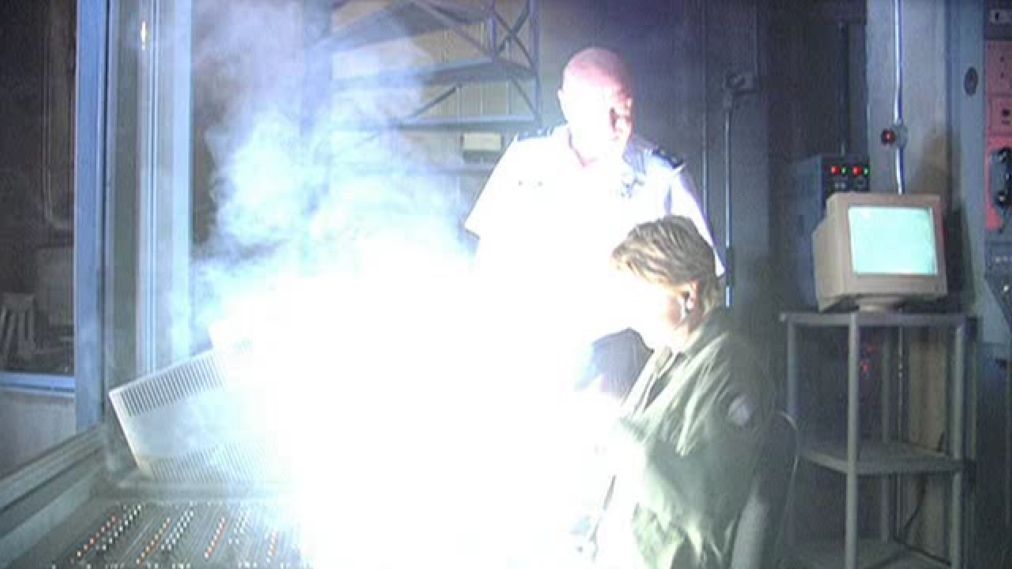
His concern will prove to be well-founded. Nobody has time to ponder it, however, as the MALP is seemingly struck by lightning and becomes airborne. Instead of shorting out, however, it sends a high-powered radio transmission into Stargate Command’s computers. One technician (Gary Jones) is knocked unconscious and Major Carter (Amanda Tapping) nearly electrocuted by her keyboard before O’Neill effects an emergency shutdown. A careless viewer, such as this author, might assume this is the point where—spoiler alert—Carter is invaded by a disembodied, extraterrestrial being. But no, the Entity has merely insinuated itself into the SGC mainframe.
Assessing the damage later, Carter informs Hammond that the database is, as Sam later says “trashed.” Carter’s left hand has been burned, and she and Dr. Fraiser (Teryl Rothery) proceed to bicker like an old married couple. Judging by his ‘Entity’ script and ‘Rite of Passage’ (S5, Ep6) direction, Better Than Chocolate fan DeLuise is a crypto-Sam/Janet shipper. (Tapping and Rothery have far more sexual tension between them than Tapping and Anderson, who play love scenes as though held at gunpoint.)
Samantha Carter: I’d like to run a full systems diagnostic on the main computer.
Janet Fraiser (noticing the burn): Yeah, after I treat this hand.
Samantha Carter: As soon as I get the systems up …
Janet Fraiser: This is a very bad burn, Sam.
Samantha Carter: Five minutes.
Janet Fraiser: Now!
Jack O’Neill: Do as the doctor says.
Samantha Carter: Yes sir.
Janet Fraiser: Thank you, Colonel. You, Daniel, and Teal’c are next.
Daniel Jackson/Jack O’Neill: We’re/I’m fine.
Janet Fraiser: Well, I would like to be the judge of that. Some form of energy came through the Stargate. I think it’s only prudent to make sure there was no physiological effect to those exposed—ASAP. (Leaves)
Jack O’Neill: Who put her in charge?
George Hammond (glowering): The U.S. Air Force.
Teal’c: In medical matters, Dr. Fraiser may overrule those of any rank. (Exits)
Jack O’Neill: I’m not getting all my memos.
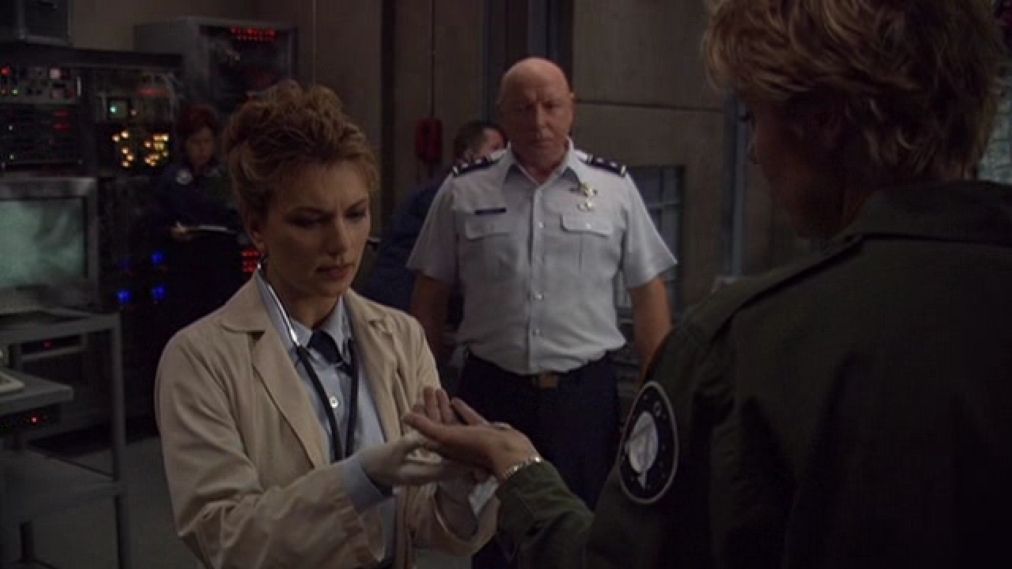
In addition to the humor of the writing, this scene showcases the deft acting of Teryl Rothery. In one of those physical grace notes that define Janet, she punctuates“ASAP” by snapping off her glove and sliding out of the frame, neatly punctuating the dialogue. Dr. Fraiser’s examination of Major Carter turns up nothing abnormal, but Lee closes in on the monitor to show something or someone rifling through Carter’s computerized medical files.
Trying to make sense of the alien signal, Sam and Daniel isolate a waveform that hitched a ride through the Stargate via MALP telemetry. Daniel deduces, from the targeted databases, that extraterrestrial intelligence is “learning to read, learning to talk.” What they don’t know is that it’s already in the mainframe and hijacking the security cameras to surveil them. (To depict the Entity’s HAL 9000-like point of view, Lee cuts soundless, black-and-white video footage into the otherwise colorful master.)
Poring over preliminary documentation in “the boardroom,” Hammond and SG-1 struggle to make sense of the data. Dr. Fraiser is the first to detect the nature of what they’re dealing with, “high-amplitude tracings of an EEG,” in other words, a brainwave. At this point, the Entity announces itself by killing the lights and commandeering Hammond’s video screen. Jack toys with it but the others are not amused, especially when the Entity begins pulling up personnel files, specifically those of SG-1. Jackson is inclined to allow it to keep learning but the general won’t have it:
Daniel Jackson: We don’t even know its intentions.
George Hammond: Doctor, I can’t allow an alien intelligence into our computer systems, whatever its intentions.
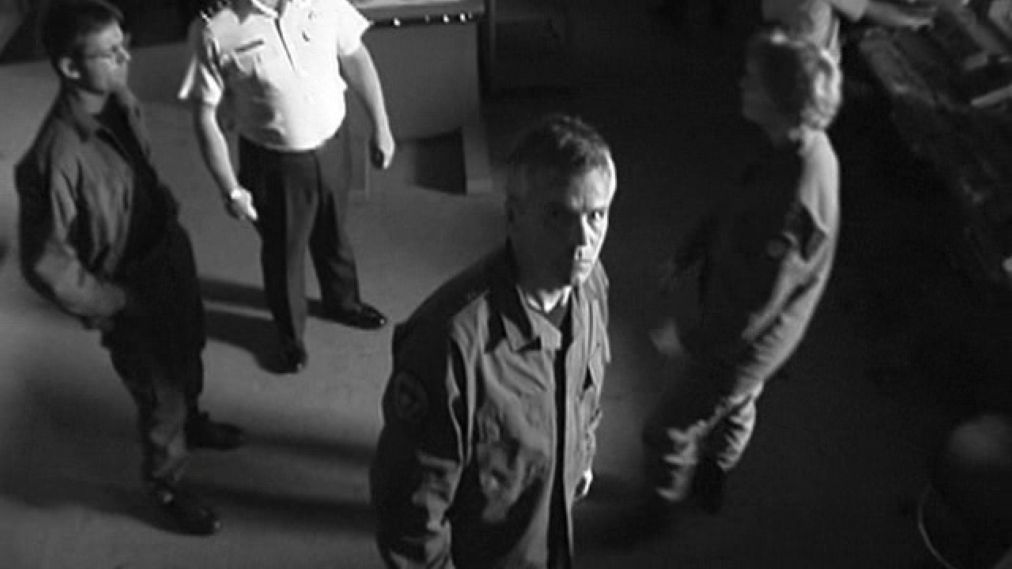
God bless Don S. Davis. He could sell any science-fiction scenario, no matter how implausible it might sound at first blush. While Jack is still wont to treat the Entity like a pet dog (“I think it likes me”), Carter has diagnosed the intruder as equivalent to a supercomputer, as complex as a strand of DNA. She has Siler (Dan Shea) power down the entire base. As the computers die, they emit a wail like that of a baby, an aural hint of what SG-1 is really dealing with, sentient life. But before matters turn grievously serious, there is one last calm before the storm. O’Neill is informed by Carter that there is a power anomaly in the MALP room:
Jack O’Neill: Forget to change lightbulbs, Sergeant Siler?
Siler: It’s not my job, sir. (O’Neill glares at him) Yes, sir. Lightbulb. Very amusing.
It takes a blowtorch for the team to cut its way in and what they discover is a marvelously and frighteningly indescribable mass of cables, batteries, monitors—and a computer keyboard, an invitation for SG-1 to communicate with what C.S. Lewis might well have titled That Hideous Strength. (Lewis’ subtitle for the said novel, “A Modern Fairy Tale for Grown-Ups,” could describe all of Stargate SG-1.) Carter assesses this as a “memory mainframe.”
Jack’s immediate inclination is to call for claymore mines to blow the intruder to Kingdom Come. Daniel, always striving to see matters from every perspective involved, takes a pacifist approach, trying to reason with both the intruder and O’Neill. If Jack has been fart-assing around earlier, he’s becoming noticeably more serious and will continue to do so, a beautifully gauged crescendo of emotion from Richard Dean Anderson.
Daniel Jackson: It’s obviously fighting to survive.
Jack O’Neill: So do bacteria!
Samantha Carter: It’s trying to communicate.
Jack O’Neill: So do bac …
Samantha Carter: Sir, I agree with Daniel. This is a lifeform – obviously intelligent. Now we’ve been in the exact same position as this alien entity I don’t know how many times: trapped on another planet, cut off from our world, trying to stay alive.
Spotting the keyboard and underestimating the threat being posed to Stargate Command, Carter decides to interface with the alien. She types a seemingly simple query.
Samantha Carter: What is your purpose here?
Entity: (assessing threat posed by Jack) What is yours?
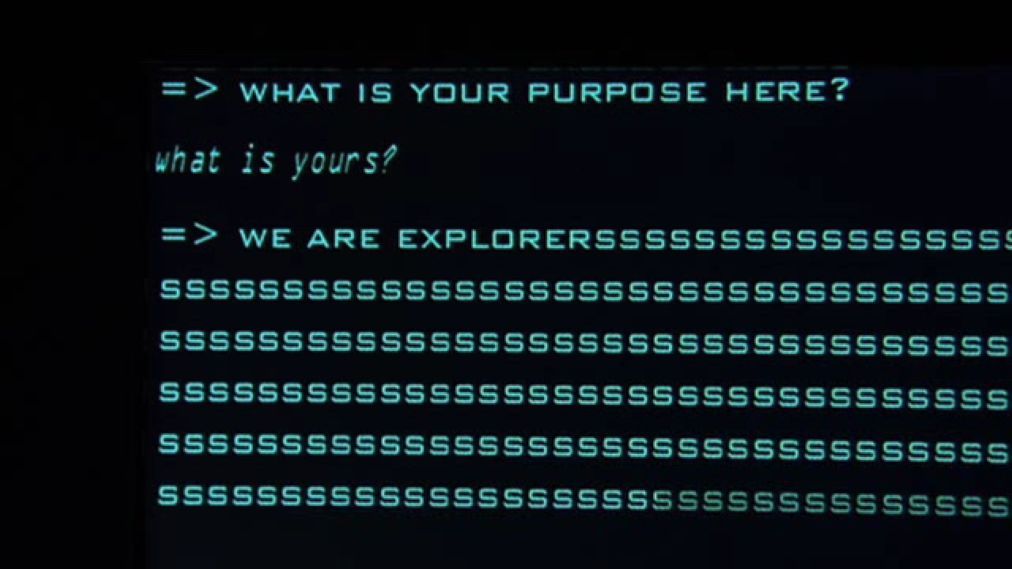
Sam is clearly unprepared to be posed with an existential question. Before she can reply, she becomes hypnotized by the onscreen display, then pumped full of thousands of volts of electricity through the keyboard. If anything is amply evident by this point, it is that SG-1 is dealing with formless, invisible alien beings composed of electromagnetic energy, something with which they are clearly unprepared to contend. The next thing we know, Carter is being defibrillated but is revived not by Fraiser but by the Entity, which is now—as Janet realizes, to her horror—inside Sam.
The Invaders Become the Invaded
The Entity’s Manifest Destiny, so far, has been accomplished. It is, as the good doctor explains, overwriting Sam’s memory with its own, having found in the human brain a storage capacity greater than any computer. An increasingly distraught Janet is powerless to remove it, her voice breaking with tears when she later tells Jack, “I don’t know how.” Even Jack is at a loss. For the moment, Teal’c—coolly bottom-line oriented in times of crisis, suggests that Carter be placed under guard as security and Hammond seconds the motion: “The Entity has fooled us twice and I’ll be damned if I let it do it again.”
As the Entity-possessed Carter, Tapping is quite chilling, conveying the alien’s consciousness through a hard, fixed gaze, stylized deadpan, and minimalistic gestures. Taking his cue from Daniel, Jack tries communicating with the Entity on its own terms. After some rhetorical fencing, they get down to brass tacks.
Entity: There was no other choice, no other place to go. You wish to terminate.
Jack O’Neill: Still do!
Entity: But you will not. Not now. I have observed. You value the life of one.
Jack O’Neill: Yes, we do.
Entity: This one is important.
Jack O’Neill: She is.
Entity: For this reason, this one was chosen. You will not terminate this one in order to destroy me.
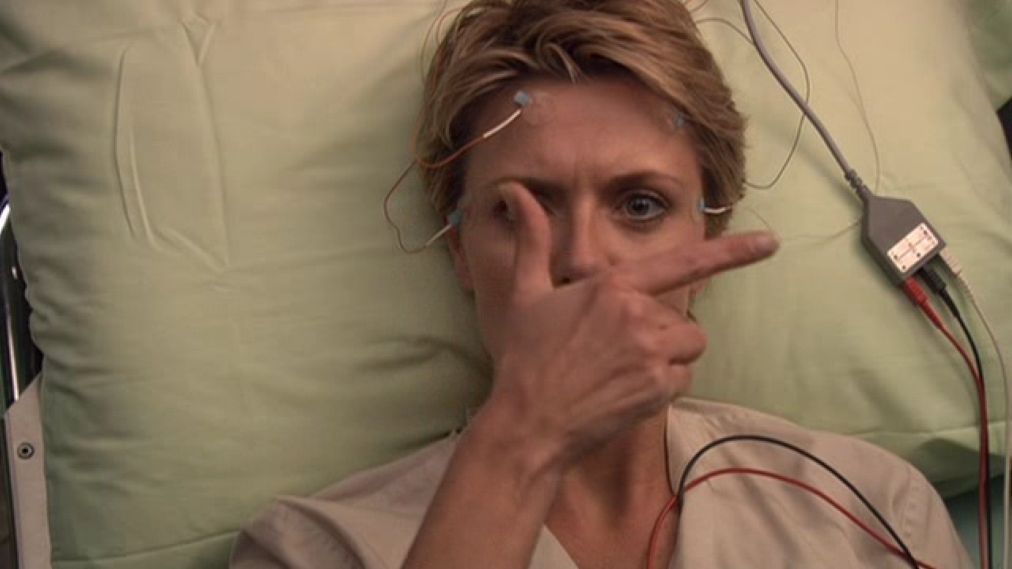
Ah, the Entity has discovered Jack’s weakness, his tendency to care for Sam “more than I should.” The Entity is using Sam/Jack to hold the entire base hostage. If the Entity dies, it announces, so will Sam, “therefore I will survive.” Daniel suggests offering the Entity a way home but Hammond shuts that down. He then buttonholes Jack.
George Hammond: We may have to make some difficult choices. I know that Major Carter means a great deal to you.
Jack O’Neill: She’s a very valuable member of my team, sir.
George Hammond: Yes, she is.
Davis can speak volumes with three words, can’t he? In the climactic confrontation with the Entity, Daniel attempts to broker a diplomatic solution. This is where the penny drops. The MALP sent through the gate was interpreted as an attack. It unleashed collateral damage that SG-1 could not have anticipated, an electrostatic contagion that has wreaked enormous damage within the alien life forms: “It spread before we understood it was poison.”
This was SG-1’s ‘smallpox blanket,’ however benevolently intended, and a comparable contagion has been visited upon them in return. The Entity’s endgame was to invade the Cheyenne Mountain computers with the intention of destroying Stargate Command and everyone in it. Only Hammond’s emergency shutdown thwarted the fruition of this assault, leaving the Entity in the computers and, eventually, in Sam, its final act of revenge. Daniel makes one last appeal:
Daniel Jackson: In a way you succeeded. We won’t go back there. You can repair the damage we did and we won’t send any more probes through.
Jack O’Neill: Yes, we will.
Daniel Jackson: Jack?
Jack O’Neill: We’ll send dozens of ‘em, one after another. I don’t care what it does.
Entity: No.
Jack O’Neill: Leave her—now.
Entity: You won’t.
Jack O’Neill: You’ve read my file, think again.
Anderson is fully ablaze by this point, as O’Neill says he’s going to stick to his guns no matter how much the Entity protests that he can’t. (“You’re damn right we can,” Hammond interposes.) When watching the episode, our pulses quicken as Jack calls the Entity’s bluff. Afterward, we realize that he is threatening genocide in order to get Sam back, threatening the extermination of untold numbers of lives to save one. O’Neill’s, Hammond’s—and DeLuise’s—moral compasses seem to have gone wildly off-balance, although we recall that Hammond was perfectly willing to nuke Abydos in ‘Children of the Gods’ (S1, Ep1) and Jack admits to having done “damned distasteful things” when he was in black ops. So their hands are not clean. It’s a very rare instance in Stargate SG-1 when the characters find themselves written into a corner and have to threaten to blast their way out.
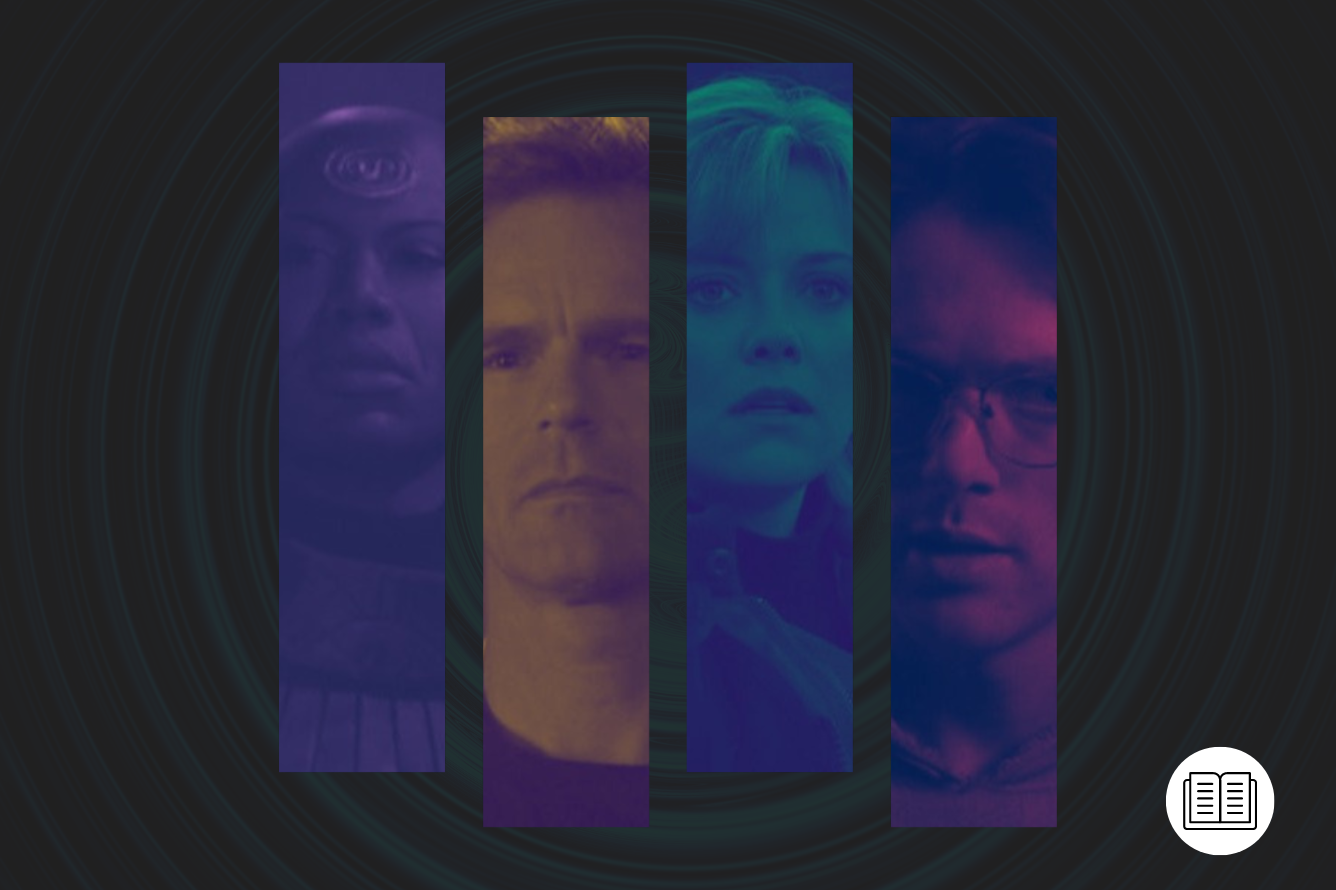
At Jack’s words, the Entity’s face twitches, and its hand trembles over the keyboard it was using to communicate. Upon O’Neill’s ultimatum, “Leave Major Carter right now,” the Entity/Carter flees sickbay and, finding itself trapped, raises its arms in a Christlike pose, radiating electric bolts in what appears to be a last, desperate attack on the base. Jack lifts his Zat gun, takes aim and shoots Carter once, then—after a long, beautifully acted pause—again, the kill shot. The Entity/Carter collapses, apparently dead. Jack is shaken and Janet downright aghast.
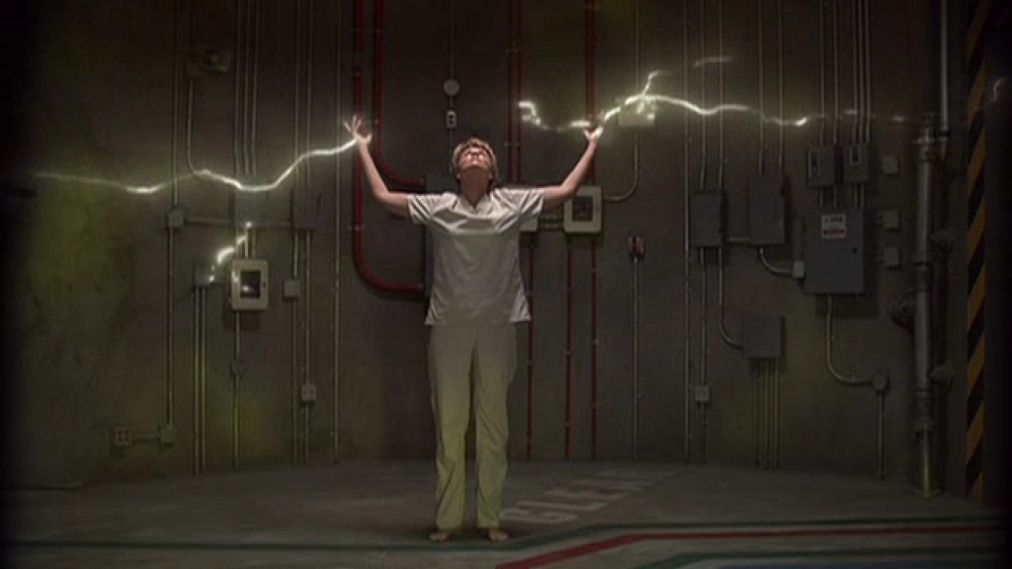
The Entity may be gone but there is still the matter of Sam’s immortal soul, or “higher consciousness” as the show would have it. The final act begins with a deeply weary Dr. Fraiser taking a long walk to the evidently brain-dead Carter’s sickbed, where she finds a sorrowful O’Neill. Two bereaved people, both in love with Carter, exchange confidences regarding Sam’s living will: “No extraordinary means.” On the verge of weeping, Janet suggests, “I think it’s time to let her go, sir.” “Just give it a minute,” Jack replies. Daniel and Teal’c enter to say their farewells but, before they can, the “memory mainframe”—seconds away from being destroyed— comes back to life, reiterating the message, “I am here” through every computer screen in the SGC.
Daniel deduces that it cannot be the Entity in the mainframe but Sam herself, that the Entity sacrificed itself (and protected Sam’s soul) in order “to preserve its home world.” Janet connects Sam to the labyrinthine electrical nest of the Entity to “provide a conduit” whereby Carter can return to her own body. An ever-wary Teal’c cocks a Zat at Carter, rationalizing that “the Entity has deceived us on several occasions. Janet flips the switch, Sam’s body surges as though massively defibrillated, and the “memory mainframe” dies once and for all. Carter begins breathing on her own and finally speaks.
Samantha Carter: I was shouting for you to hear.
Jack O’Neill: We heard.
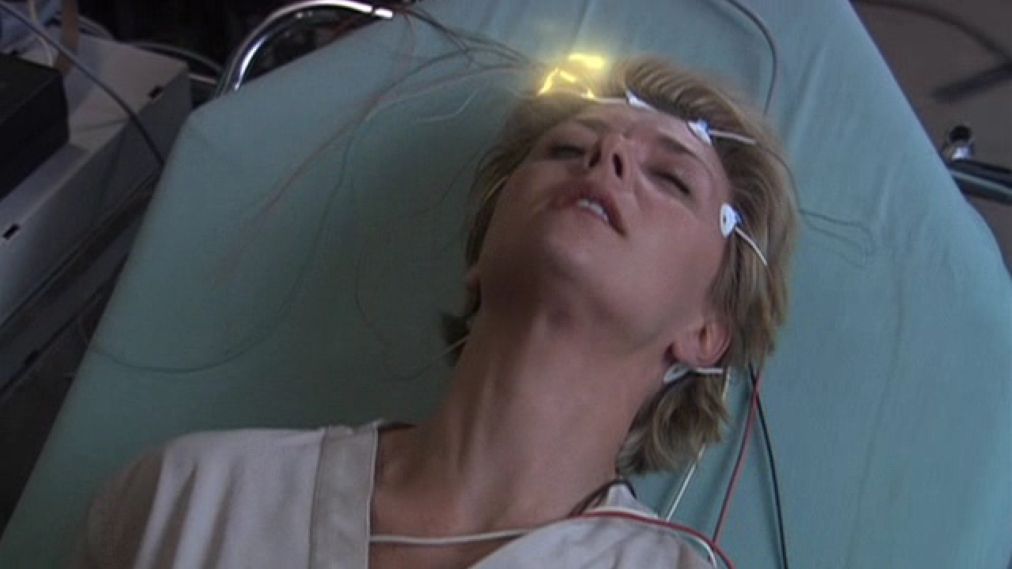
O’Neill goes to take Carter’s hand but Fraiser beats him to it. As Lee’s camera pulls up and away from the chastened but relieved SG-1 family (and that familial dynamic is one of the things that makes Stargate SG-1 so deeply endearing) we are left to wonder. Has the lesson been learned? Will Stargate Command tread more carefully through the galaxies? There are six more seasons— plus all of Stargate Atlantis—for us to decide whether the Stargate program is a projection of Manifest Destiny or, as Daniel Jackson would say, peaceful exploration.
We think the lesson was learned, and the Goa’uld, Ori, and Wraith arcs would find Earth very much on the wrong end of someone else’s idea of Manifest Destiny, the crushing boot on the other foot. We’ve often heard the phrase “the conquest of space.” Stargate SG-1 depicts something much higher: co-existence. And if that makes one a sappy idealist, so be it.
The cost of your membership has allowed us to mentor new writers and allowed us to reflect the diversity of voices within fandom. None of this is possible without you. Thank you. 🙂











